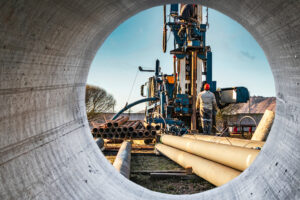A pipe chock is essentially a pipe protection product used to secure pipes during transit and storage. This product is reliable, easy to apply, and has the capacity to hold up against all weather conditions. Pipe chocks will ensure the integrity and safety of pipes while they are being transported and while in storage. Each chock is wedged between pipes to provide stabilization. Plastic chocks are made out of melded HPDE resin, and have molded nail slots. Steel chocks have big holes to accommodate chains to secure heavy or large loads of pipe.
A load of pipes not properly secured can be easily shifted by any sort of accelerated back and forth motion. This can cause serious injuries to the transportation driver, or other drivers or pedestrians in the vicinity; it could even result in death. There is often oil residue in the pipes being transported. Using pipe chocks is vital to securing this kind of load as there is an additional danger when handling pipes with a slippery coating.
In addition, chocks provide pipes with stability during sharp turns, and also during inclement weather conditions. They prevent the widespread dangers of the pipes becoming dislodged while being transported.
The chocks are intermittently nailed all throughout the pipe load, to serve as wedges between all layers of the pyramid kind of structure. They carry out the very important function of restricting any kind of rollover or movement that can cause the pipes to fall from the trailer or bed during transit. An additional safety measure used to keep pipe loads secured is tie-downs.
One of the great features of the pipe chocks is that their application and removal takes just a few seconds. This is an extremely essential safety element when it comes to ensuring that pipes are securely transported and safely placed into storage.




